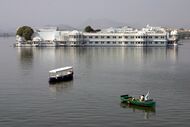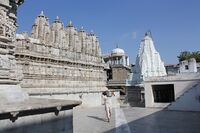أودايپور
أودايپور
Udaipur | |
|---|---|
Evening view of the city Udaipur landscape | |
| الكنية: The White City | |
| الإحداثيات: 24°35′N 73°41′E / 24.58°N 73.68°E | |
| البلد | |
| الولاية | راجستان |
| الضلع | أودايپور |
| Established | 1559 CE |
| أسسها | رانا أوداي سنغ الثاني |
| الحكومة | |
| • النوع | Municipal Corporation |
| • الكيان | Udaipur Municipal Corporation |
| • العمدة | Govind Singh Tank |
| • Municipal Commissioner | Ram Prakash, IAS[1] |
| المساحة | |
| • مدينة | 64 كم² (25 ميل²) |
| المنسوب | 423 m (1٬388 ft) |
| التعداد (2011)[3] | |
| • مدينة | 451٬100 |
| • العمرانية | 974٬531 |
| اللغات | |
| • الرسمية | هندي |
| • رسمية إضافية | الإنجليزية |
| • الإقليمية | مواري |
| منطقة التوقيت | UTC+5:30 (IST) |
| PIN | 313001- 313024 |
| Telephone code | +91- 294 |
| لوحة السيارة | RJ-27 |
| أقرب المدن | Jodhpur, Chittorgarh, كوتا، أحمد آباد، جايپور، أجمر، إندورى، دونگارپور، Banswara |
| Climate | BSh |
| الموقع الإلكتروني | www |
أودايپور (Udaipur ؛ pronunciation ) (ISO 15919 : Udayapura ), هي مدينة في ولاية راجستان، بالهند.[4][5] وهي العاصمة التاريخية للمملكة موار في وكالة راجپوتانا السابقة. وقد أسسها في 1559 أوداي سنغ الثاني من عشيرة سيسوديا من الراجپوتات،[6] when he shifted his capital from the city of Chittorgarh to Udaipur after Chittorgarh was besieged by Akbar. It remained as the capital city till 1818 when it became a British princely state,[6] and thereafter the Mewar province became a part of Rajasthan when India gained independence in 1947.[7] It is also known as the City of Lakes, as it is surrounded by five major artificial lakes.[8][9]
The city is located in the southernmost part of Rajasthan, near the Gujarat border. It is surrounded by the Aravali Range, which separates it from the Thar Desert. It is placed close to the median point between two major Indian metro cities, around 660 km from Delhi and 800 km from Mumbai. Besides, connectivity with Gujarat ports provide Udaipur a strategic geographical advantage.[10] Udaipur is well connected with nearby cities and states by means of road, rail and air transportation facilities. The city is served by the Maharana Pratap Airport. Common languages spoken include Hindi, English and Rajasthani (Mewari).
Dubbed "the most romantic spot on the continent of India" by British administrator James Tod,[11] Udaipur is a tourist destination and is known for its history, culture, scenic locations and the Rajput-era palaces. It has seven lakes surrounding the city. Five of the major lakes, namely Fateh Sagar Lake, Lake Pichola, Swaroop Sagar Lake, Rangsagar, and Doodh Talai Lake, have been included under the restoration project of the National Lake Conservation Plan (NLCP) of the Government of India.[12] Besides lakes, Udaipur is also known for its historic forts and palaces, museums, galleries, natural locations and gardens, architectural temples, as well as traditional fairs, festivals and structures.[13] Due to the several lakes present here, it is sometimes dubbed "Venice of the East".[14][15] Udaipur economy is primarily driven by tourism, though minerals, marble processing, chemical manufacturing and development, electronic manufacturing and the handicraft industry are also contributors.[16] Udaipur hosts several state and regional public offices, including offices of Director of Mines and Geology, Commissioner of Excise, Commissioner of Tribal Area Development, Hindustan Zinc Limited, and Rajasthan State Mines and Mineral Corporation Limited. Besides, Udaipur is rising as educational hub as well, with 5 Universities, 14 colleges and more than 160 high schools.[16] Udaipur is home to IIM Udaipur, the fifth best management institution in the country according to NIRF ranking released by the MHRD.
التاريخ
قبل التاريخ
The Ahar River bank was inhabited in about 2000 BCE. There are footprints of two different civilizations, which provides claims about earliest inhabitants of the Ahar culture: the first ones are the Bhil/Bheels, the indigenous tribes originated at this place, and are still residing in the area in large numbers. The second footprints were of Rajputs, who once entered the enclosed valley, and then continued to live in this place for centuries.[17]
التأسيس كمدينة

Udaipur was founded in 1559,[6] by Maharana Udai Singh II in the fertile circular Girwa Valley to the southwest of Nagda, on the Banas River. The city was established as the new capital of the Mewar kingdom. This area already had a thriving trading town, Ayad, which had served as the capital of Mewar in the 10th through 12th centuries.[6] The Girwa region was thus already well known to Chittorgarh rulers who moved to it whenever the vulnerable tableland Chittaurgarh was threatened with enemy attacks. Rana Udai Singh II, in the wake of the 16th-century emergence of artillery warfare, decided during his exile at Kumbhalgarh Fort to move his capital to a more secure location. Ayad was flood-prone, hence he chose the ridge east of Pichola Lake to start his new capital city, where he came upon a hermit while hunting in the foothills of the Aravalli Range. In the myth, the hermit blessed the king and guided him to build a palace on the spot, assuring him it would be well protected. Udai Singh II consequently established a residence on the site. In November 1567, the Mughal Emperor Akbar conquered Chittor. To protect his territory from attack, Rana Udai Singh built a six-kilometre-long city wall, with seven gates,[18] namely Surajpole, Chandpole, Udiapole, Hathipole, Ambapole, Brahmpole, Delhi Gate, and Kishanpole. The area within these walls and gates is still known as the old city or the walled city.
In September 1576, Akbar himself arrived at Udaipur and remained there for 6 months until May 1577.[19] In 1615, Rana Amar Singh accepted vassalship to Mughal rule under Emperor Jahangir and Udaipur remained the capital of the state, which became a princely state of British India in 1818. Being a mountainous region and unsuitable for heavily armoured Mughal horses, UdaipurUdaipur remained safe from Mughal influence despite much pressure.[بحاجة لمصدر] At present, Maharana Mahendra Singh Mewar is the 76th custodian of the Mewar dynasty.
الجغرافيا والمناخ
| بيانات المناخ لـ مطار أودايپور (1981–2010، القصوى 1965–2012) | |||||||||||||
|---|---|---|---|---|---|---|---|---|---|---|---|---|---|
| الشهر | ينا | فب | مار | أبر | ماي | يون | يول | أغس | سبت | أكت | نوف | ديس | السنة |
| القصوى القياسية °س (°ف) | 33.3 (91.9) |
37.0 (98.6) |
42.0 (107.6) |
44.0 (111.2) |
46.4 (115.5) |
46.2 (115.2) |
41.4 (106.5) |
38.4 (101.1) |
38.8 (101.8) |
39.4 (102.9) |
36.6 (97.9) |
34.0 (93.2) |
46.4 (115.5) |
| متوسط القصوى اليومية °س (°ف) | 24.6 (76.3) |
27.7 (81.9) |
33.4 (92.1) |
37.8 (100.0) |
40.2 (104.4) |
37.6 (99.7) |
32.2 (90.0) |
30.5 (86.9) |
32.5 (90.5) |
33.5 (92.3) |
29.6 (85.3) |
26.0 (78.8) |
32.1 (89.8) |
| متوسط الدنيا اليومية °س (°ف) | 7.3 (45.1) |
9.6 (49.3) |
15.4 (59.7) |
20.6 (69.1) |
25.5 (77.9) |
26.3 (79.3) |
24.7 (76.5) |
23.4 (74.1) |
21.7 (71.1) |
17.0 (62.6) |
12.0 (53.6) |
8.2 (46.8) |
17.6 (63.7) |
| الصغرى القياسية °س (°ف) | −1.2 (29.8) |
−1.3 (29.7) |
5.1 (41.2) |
10.0 (50.0) |
15.2 (59.4) |
19.0 (66.2) |
20.0 (68.0) |
19.0 (66.2) |
13.4 (56.1) |
9.4 (48.9) |
3.4 (38.1) |
−0.9 (30.4) |
−1.3 (29.7) |
| متوسط تساقط الأمطار mm (inches) | 2.4 (0.09) |
2.7 (0.11) |
1.4 (0.06) |
6.8 (0.27) |
13.8 (0.54) |
81.3 (3.20) |
208.8 (8.22) |
208.5 (8.21) |
94.8 (3.73) |
12.8 (0.50) |
11.2 (0.44) |
2.2 (0.09) |
646.7 (25.46) |
| Average rainy days | 0.2 | 0.4 | 0.2 | 0.6 | 1.2 | 4.5 | 8.8 | 9.8 | 5.1 | 1.0 | 0.7 | 0.3 | 32.8 |
| متوسط الرطوبة النسبية (%) (at 17:30 IST) | 33 | 26 | 21 | 19 | 24 | 43 | 65 | 72 | 59 | 35 | 36 | 38 | 39 |
| Source: India Meteorological Department[20][21] | |||||||||||||
| بيانات المناخ لـ مدينة أودايپور (القصوى 1901–2008) | |||||||||||||
|---|---|---|---|---|---|---|---|---|---|---|---|---|---|
| الشهر | ينا | فب | مار | أبر | ماي | يون | يول | أغس | سبت | أكت | نوف | ديس | السنة |
| القصوى القياسية °س (°ف) | 30.8 (87.4) |
36.7 (98.1) |
39.1 (102.4) |
44.4 (111.9) |
44.6 (112.3) |
43.4 (110.1) |
40.0 (104.0) |
35.6 (96.1) |
37.8 (100.0) |
37.7 (99.9) |
35.0 (95.0) |
33.8 (92.8) |
44.6 (112.3) |
| الصغرى القياسية °س (°ف) | 0.9 (33.6) |
0.4 (32.7) |
5.2 (41.4) |
10.6 (51.1) |
16.3 (61.3) |
16.7 (62.1) |
18.6 (65.5) |
15.2 (59.4) |
11.8 (53.2) |
8.6 (47.5) |
3.8 (38.8) |
0.6 (33.1) |
0.4 (32.7) |
| Source: India Meteorological Department[21] | |||||||||||||
الديمغرافيا
| Population Growth of Udaipur | |||
|---|---|---|---|
| Census | Pop. | %± | |
| 1891 | 46٬700 | ||
| 1901 | 45٬600 | -2.4% | |
| 1911 | 46٬000 | 0.9% | |
| 1941 | 59٬600 | ||
| 1951 | 89٬600 | 50.3% | |
| 1961 | 111٬100 | 24.0% | |
| 1971 | 162٬900 | 46.6% | |
| 1981 | 229٬800 | 41.1% | |
| 1991 | 308٬600 | 34.3% | |
| 2001 | 389٬438 | 26.2% | |
| 2011 | 474٬531 | 21.9% | |
| source:[22] | |||
السياحة
القائمة
| Picture | Attraction | Period | الوصف |
|---|---|---|---|
 |
City Palace, Udaipur | 1559 | Standing on the east bank of Lake Pichola is a massive series of palaces built at different times from 1559. Its main entrance is through the triple-arched gate - the Tripolia, built in 1725. This gate leads to a series of courtyards, overlapping partitions, terraces, corridors and gardens. The palace now houses a museum with many antique articles, paintings, decorative furniture and utensils from the royal era. |
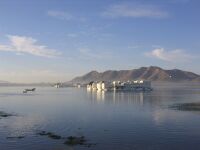 |
Lake Palace | 1743–1746 | Situated over an island in Lake Pichola, the Lake Palace was constructed to serve as a royal summer palace. Built of white marble, the palace is now a luxury 5 Star hotel, operating under the "Taj Hotels Resorts and Palaces" banner. |
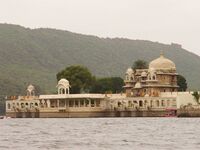 |
Jag Mandir | 1551–1652 | Jag Mandir is a palace built on an island in the Lake Pichola. Also known as the "Lake Garden Palace", it was constructed by three Maharanas of the Mewar kingdom. The construction started in 1551 and was completed by 1652. The royal family used the palace as a summer resort and pleasure palace. |
| Kesariyaji Temple | 9th century |
The temple is dedicated to Lord Rishabh dev, the first Jain Tirthankara. The fifty-two pinnacles of the temple are seen from a long distance. The main idol in the temple is of Tirthankara Rishabha, carved in black stone in padmasana posture, about 3.5 feet (1.1 m) tall. | |
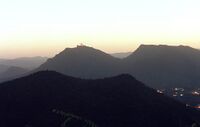 |
Monsoon Palace | - | Monsoon Palace, also known as Sajjan Garh Palace, was built as an astronomical center to keep track of the movement of monsoon clouds in the area and also served as the summer resort of the Maharanas. Built with white marble, it is located on Bansdara peak of the Aravalli hill range at an elevation of 944 m (3100 ft) above mean sea level. The palace has view of the city's lakes, palaces, and surrounding countryside. |
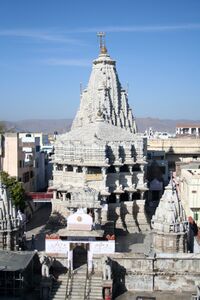 |
Jagdish Temple | 1651 | The Jagdish Temple is a large Hindu temple in the middle of Udaipur, built by Maharana Jagat Singh I. A key tourist place in the city, this temple is an example of Māru-Gurjara architecture. |
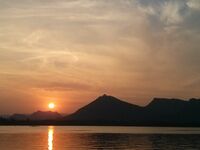 |
Fateh Sagar Lake | 1678 | Lake Fatehsagar is an artificial lake situated in the north-west part of Udaipur. The lake was originally built by Maharana Jai Singh and later reconstructed and extended by Maharana Fateh Singh. It also houses an aquarium named 'Under the Sun' inaugurated in 2017. |
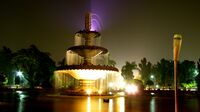 |
Sukhadia Circle | - | Sukhadia Circle (square) is large roundabout in the city's northern suburb and is a recreational centre. The square has in its centre, a small pond amidst which lies a 21 ft high three-tiered fountain. The fountain, made of marble is surmounted by a wheat-ear motif, a symbol of prosperity. |
 |
Saheliyon-ki-Bari | 1710–1734 | Sahelion ki Bari is a garden and tourist space in the northern part of the city. The garden with its fountains and kiosks, a lotus pool and marble elephants, was laid for a group of forty-eight young women attendants who accompanied a princess to Udaipur as part of her dowry. |
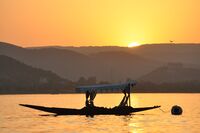 |
Lake Pichola | 1362 | Lake Pichola is an artificial freshwater lake and is one of the several contiguous lakes in the city of Udaipur. The lake's surroundings and the several islands within the lake have been developed over the centuries, with palaces, marble temples, family mansions, bathing ghats (Gangaur Ghat, Ambrai Ghat, Hanuman Ghat) and chabutaras (a raised platform, normally within a courtyard) |
 |
Moti Magri | - | Moti Magri or Pearl Hill, is a memorial of the Rajput hero Maharana Pratap. It is basically a small hill, atop of which there is a bronze statue of the Maharana astride his favourite horse "Chetak". It was initiated by Maharana Bhagwat Singh Mewar, and carried over and completed with the help of public trust. |
| Neemach Mata Temple | - | Neemach mata is located on a hill near Fateh Sagar Lake. The temple is 900 meters above on the top of the hill. This location provides a holistic view of entire Udaipur. | |
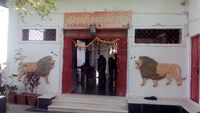
|
Karni Mata, Udaipur | - | Karni mata temple is located at Doodh Talai near Pichola. There is a rope-way which takes visitors to a hill at which this temple is located. There are views of Pichola Lake, Jag Mandir and Doodh Talai. From the top one can view the whole city. |
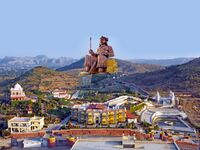
|
Pratap Gaurav Kendra | - | Pratap Gaurav Kendra Rashtriya Tirtha is situated at Tiger Hill. It was started by the Veer Shromani Maharana Pratap Samiti, and aims at providing information about Maharana Pratap and the historical heritage of the area with the help of modern technology. |
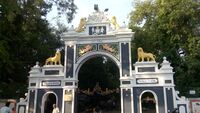
|
Gulab Bagh and Zoo | - | Gulab Bagh is the largest garden in Udaipur, situated at heart of the city. It is known for a wide variety plantation and includes various attractions including ponds, a library, toy train, zoological park, temples and a religious place for Arya Samaj, as well as several government offices. |
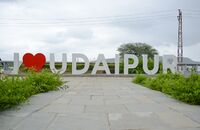
|
Pratap Park | 2016 | Pratap Park is a garden situated near the bank of Pichola Lake. It has an open gymnasium and several other attractions.[بحاجة لمصدر] It has gained attraction[بحاجة لمصدر] due to the human-sized alphabets reading "I LOVE UDAIPUR", with a view of Lake Pichola and City Palace in the background. |
الثقافة

Udaipur has a rich cultural heritage from the past e.g. lakes, temples, huge forts, and palaces.[23] The city has kept a balance between preserving the rituals and traditions of the past while keeping up with the modern advancements and changes in lifestyle{citation needed}. Like any other place in the state of Rajasthan, folk dance and music have an important place in adding to the city's cultural richness. The dynamic and vibrant dances of Bhavai, Ghoomar, Kachchhi Ghodi, Kalbeliya, and Terahtaali add a sparkle to the rich cultural heritage of Udaipur.
- Ghoomar dance is a part of the Hindu culture of the Mewar Region of Rajasthan. This is a community dance for women and performed on auspicious occasions where the ladies move in circles.
- Kalbelia, one of the most sensuous dance forms of Rajasthan, is performed by the Kalbeliya snake charmers' community with the Sapera dancers wearing long, black skirts embroidered with silver ribbons.
- Bhavai dance consists of veiled women dancers balancing up to seven or nine brass pitchers as they pirouette and then swaying with the soles of their feet on the top of a glass or on the edge of the sword.[24]
- Kachchhi Ghodi dance is performed on dummy horses where men in elaborate costumes ride the decorated dummy horses. Holding swords, these dancers move to the beating of drums and fifes.[25]
Following a lineage of traditions and religious significance, the various dances complement the fairs and festivals held in the city. The music consists mainly of the use of morchang, naad, tanpura, and sarangi, among many other instruments.[26]
Miniature paintings are amongst the most famous paintings developed under the patronage of the rulers of Rajasthan. The simplest among these are done on walls, and through folk in style, they nevertheless have some of the flavors of frescoes one sees in the old palaces. The tradition of painting the wall of houses with scenes from mythological and chivalric tales has been prevalent in Rajasthan for the past many centuries {citation needed}. The people of the city make use of such wall paintings for decorations during wedding celebrations. Noted amongst the miniature style of paintings are particularly the Pichvais, which are those made on cloth, and phad, made on cloth scroll in a folk style.[25]
The Bharatiya Lok Kala Mandal is a cultural institution based in the city. The institute with its museum is a platform that displays a collection of Rajasthani culture. Offering an insight into the lifestyle of the royal era in Udaipur, the museum has a collection of dresses, tribal jewelry, turbans, dolls, masks, musical instruments, paintings, and puppets. With various cultural events including folk song and dance performances, theatre and puppetry, the institute highlights the different social stigmas, thereby proving to be a powerful education tool for the masses.[27][28]
انظر أيضاً
- Udaipur district
- Udaipur division
- Tourist Attractions in Udaipur
- History of Udaipur
- Mahakaleshwar Temple Udaipur
المراجع
- ^ "Administration : Udaipur Municipal Corporation". June 2024.
- ^ "Udaipur Municipal Corporation - Annual Report 2015-16" (PDF). Janaagraha. Archived (PDF) from the original on September 20, 2018. Retrieved September 22, 2021.
- ^ خطأ استشهاد: وسم
<ref>غير صحيح؛ لا نص تم توفيره للمراجع المسماةc2011 - ^ خطأ استشهاد: وسم
<ref>غير صحيح؛ لا نص تم توفيره للمراجع المسماةUdaipur location - ^ Srivastava, Soumya (July 30, 2017). "Weekend at Udaipur: Two days are all you need to fall in love with the city of lakes". Hindustan Times. Archived from the original on July 30, 2017. Retrieved 30 August 2017.
- ^ أ ب ت ث "Udaipur History". Official Website of Udaipur via Government of Rajasthan. Archived from the original on June 23, 2015. Retrieved November 26, 2015.
- ^ "Udaipur History". Udaipur.org.uk. Archived from the original on 2 November 2007. Retrieved 31 August 2015.
- ^ "Udaipur - About". Andbeyond.com.
- ^ "Udaipur - The City of Lakes | Best Lakes in Udaipur". www.bamboosaa.com (in الإنجليزية). Retrieved 2024-03-27.
- ^ "Udaipur Location". Udaipur.org.uk. Archived from the original on 2 November 2007. Retrieved 9 September 2017.
- ^ "Welcome to Udaipur". lonelyplanet.com. Archived from the original on 11 November 2020. Retrieved 7 April 2018.
- ^ Reddy, M.S.; Char, N.V.V. (10 March 2004). "Management of Lakes in India" (PDF). worldlakes.org. (NLCP) - National Lake Conservation Plan. Archived (PDF) from the original on 29 May 2005. Retrieved 31 August 2015.
- ^ "Udaipur Tourist Attractions". Udaipur.org.uk. Archived from the original on 10 February 2006. Retrieved 9 September 2017.
- ^ India (2 February 2008). "Udaipur: An eternal melding of the ages". Telegraph. Retrieved 2012-10-29.
- ^ "Udaipur (Venice of the East)". Technology Development for Indian Languages. Archived from the original on 27 January 2010.
- ^ أ ب "Local Economy" (PDF). Udaipurmc.org. Udaipur Municipal Corporation. Archived from the original (PDF) on 9 September 2017. Retrieved 9 September 2021.
- ^ "Prehistoric Era of Ayad". UdaipurTimes.com. 12 October 2010. Archived from the original on 15 October 2010. Retrieved 12 September 2017.
- ^ Jain, Manishika (2009). GIS and Remote Sensing Techniques (2009 ed.). Examrace.com, 2009. p. 36. ISBN 978-81-7906-190-9. Retrieved 17 May 2016.
- ^ "The Akbarnama of Abu Fazl". persian.packhum.org. Archived from the original on 14 August 2017. Retrieved 14 August 2017.
- ^ "Station: Udaipur (Dabok)(A) Climatological Table 1981–2010" (PDF). Climatological Normals 1981–2010. India Meteorological Department. January 2015. pp. 767–768. Archived from the original (PDF) on 5 February 2020. Retrieved 20 January 2021.
- ^ أ ب "Extremes of Temperature & Rainfall for Indian Stations (Up to 2012)" (PDF). India Meteorological Department. December 2016. p. M188-M189. Archived from the original (PDF) on 5 February 2020. Retrieved 20 January 2021.
- ^ "Historical Demographical Data of the Urban Centers". populstat.info. Archived from the original on March 31, 2019. Retrieved March 31, 2019.
- ^ "Udaipur Guide". jüSTa (in الإنجليزية الأمريكية). 2022-09-27. Retrieved 2023-03-22.
- ^ Pedia, Team Utsav (2017-03-15). "Bhavai Dance: Know Everything About The Most Exciting Folk Dance From Rajasthan". Utsavpedia (in الإنجليزية الأمريكية). Retrieved 2023-06-22.
- ^ أ ب "Udaipur Art and Culture". amazingudaipur.com. Archived from the original on January 6, 2009. Retrieved January 6, 2009.
- ^ "Culture of Udaipur". Udaipurian.com. Archived from the original on September 27, 2020. Retrieved September 27, 2020.
- ^ Ganguly, Nivedita (August 15, 2014). "The ancient art of storytelling". The Hindu. Retrieved August 15, 2014.
- ^ "Bharatiya Lok Kala Museum". Udaipur.org.uk. Archived from the original on February 10, 2006. Retrieved February 10, 2016.
- "Udaipur State (also called Mewar)". The Imperial Gazetteer of India. 1909. p. 85.
- Masters, Brian (1990). Maharana: the story of the rulers of Udaipur. Mapin Pub. ISBN 0-944142-28-1.
- Mehra, S, Mehra, S. P. & Sharma, K. K. (2012). Importance of aquatic avifauna in southern Rajasthan, India. Pg. 159–183. (In: Rawat., M. & Dookia, S. (eds.) Biodiversity of Aquatic Resources, Daya Publishing House, Delhi, 2012) (978-81-7035-789-6)
- Mehra, S, Mehra, S. P. & Sharma, K. K. (2012). Aquatic Avifauna: Its Importance for Wetland conservation in Rajasthan, India. Pg. 179–190. (In: Mathur, S. M.; Shrivastava, V. K. & Purohit, R. C. (eds.) Conservation of Lakes and Water Resources Management strategies, Himanshu Publications, Udaipur, 2011) (978-81-7906-263-0) Mehra, S, Mehra, S. P. & Sharma, K. K. (2011). Aquatic avifauna of Aravalli Hills Rajasthan, India. pp. 145–167 (In Gupta, V. K. & Verma, A. K. (eds.) Animal Diversity, Natural History and Conservation Vol. I, Daya Publishing House, Delhi, 2011) (ISBN 978-81-7035-752-0)
- Sharma, K. K. & Mehra, S. P. (2007). Need of studies on anuran in habitats of southern Rajasthan. Frogleg 13: 12–16.
- Islam, M. Z. & Rahmani, A. R. (2004). Important Bird Areas of India: Priority Sites for Conservation. Indian Bird Conservation Network: Bombay Natural History Society and BirdLife International (UK). Pp. xviii + 1133. (ISBN 0-19-567333-6)
وصلات خارجية
- CS1 الإنجليزية الأمريكية-language sources (en-us)
- Short description is different from Wikidata
- Pages using multiple image with auto scaled images
- Pages using gadget WikiMiniAtlas
- Articles with hatnote templates targeting a nonexistent page
- Articles with unsourced statements from December 2022
- Articles with unsourced statements from August 2019
- Pages with empty portal template
- أودايپور
- Smart cities in India
- Cities and towns in Udaipur district
- Former capital cities in India
- أماكن مأهولة تأسست في 1559
- تأسيسات 1559 في الهند
- Former capitals of Mewar





